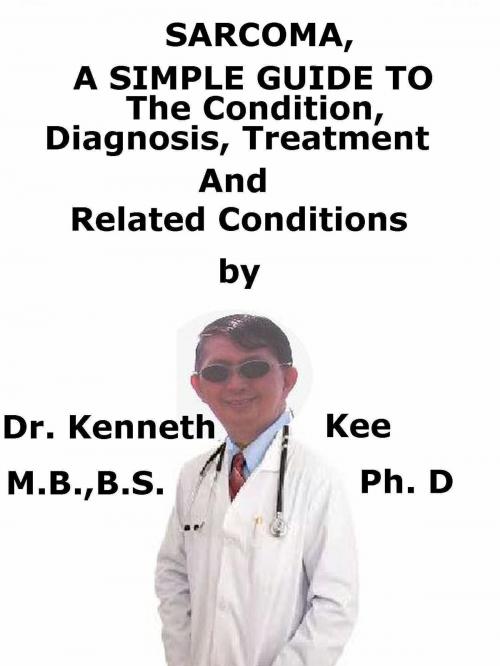Sarcoma, A Simple Guide To The Condition, Diagnosis, Treatment And Related Conditions
Nonfiction, Health & Well Being, Health, Ailments & Diseases, Cancer| Author: | Kenneth Kee | ISBN: | 9781370860821 |
| Publisher: | Kenneth Kee | Publication: | March 26, 2017 |
| Imprint: | Smashwords Edition | Language: | English |
| Author: | Kenneth Kee |
| ISBN: | 9781370860821 |
| Publisher: | Kenneth Kee |
| Publication: | March 26, 2017 |
| Imprint: | Smashwords Edition |
| Language: | English |
Sarcoma is a rare type of aggressive tumor that starts in the primitive tissues of the body.
These tissues attach, support and enclose other body structures.
The tissues are muscle, fat, bone, blood vessels, nerves, tendons and the lining of the joints.
Sarcoma can happen anywhere in the body, but the most frequent types happen in the abdomen and in the arms and legs.
Sarcomas normally start from soft tissue or bony sites on the body, giving rise to the main division into bony and soft tissue sarcomas.
There are more than 30 different subtypes of sarcomas mentioned.
These are comparatively rare cancers that consist of 1% of all malignancies.
Different subtypes of sarcoma involve patients from different age groups; no one particular age group is more often affected with all sarcoma subtypes.
Generally, cancer happens when cells form errors (mutations) in their DNA.
The errors make cells proliferate and multiply out of control.
The collection of abnormal cells develops into a tumor that can proliferate to attack nearby structures and extend to other parts of the body.
Factors that may increase the risk of sarcoma are:
1. Inherited syndromes.
A risk of soft tissue sarcoma can be inherited from the parents.
Genetic syndromes that increase the risk include hereditary retinoblastoma, Li-Fraumeni syndrome, familial adenomatous polyposis, neurofibromatosis, tuberous sclerosis and Werner syndrome.
Patients with hereditary diseases such as neurofibromatosis who have numerous benign swellings of nerve sheaths have a higher danger of one of these enlarged nerve sheaths turning cancerous.
2. Chemical exposure.
Being exposed to certain chemicals, such as herbicides, arsenic and dioxin, may increase the risk of soft tissue sarcomas.
3. Radiation exposure.
Previous radiation treatment for other cancers can increase the risk of soft tissue sarcomas.
Patients with prior radiotherapy have a slightly higher chance of developing a sarcoma within the previously radiated area.
A sarcoma may not cause any signs and symptoms in its early stages.
As the tumor proliferates, it may cause:
1. A visible lump or swelling
2. Pain, if a tumor presses on nerves or muscles
Many patients first see a doctor because of a lump or mass on the trunk, leg or arm.
The swelling may or may not be painful.
The sarcoma is diagnosed when a biopsy of a lump on the arm, leg or trunk is evaluated under a microscope
Once a sarcoma is diagnosed, other tests such as magnetic resonance image scanning (MRI) of the location of cancer to find out the extent of the cancer and if it is operable, computerized scans (CT) of the lungs and liver to find out if the cancer has spread, are normally done.
Treatment of Sarcoma
The treatment options for sarcoma will depend on the size, form and site of the tumor.
Surgery is a frequent treatment for soft tissue sarcoma.
Surgery normally requires removing the cancer and some healthy tissue surrounding it.
When soft tissue sarcoma involves the arms and legs, it may be require to amputate the involved arm or leg.
Doctors always attempt their best to prevent amputation.
One method to achieve this may be using chemotherapy and radiation to shrink the tumor before surgery
Radiation therapy requires treating cancer with high-powered beams of energy.
The doctor may indicate using radiation therapy before surgery to shrink a tumor
Radiation is also done after surgery to kill any cancer cells that have remained
Chemotherapy is a drug treatment that uses medicines to kill cancer cells.
Chemotherapy can be given by pill, through a vein .
Some forms of sarcoma react better to chemotherapy
Targeted drugs obstruct specific abnormal signals present in sarcoma cells that permit them to proliferate.
TABLE OF CONTENT
Introduction
Chapter 1 Sarcoma
Chapter 2 Causes
Chapter 3 Symptoms
Chapter 4 Diagnosis
Chapter 5 Treatment
Chapter 6 Prognosis
Chapter 7 Kaposi Sarcoma
Chapter 8 Cancer
Epilogue
Sarcoma is a rare type of aggressive tumor that starts in the primitive tissues of the body.
These tissues attach, support and enclose other body structures.
The tissues are muscle, fat, bone, blood vessels, nerves, tendons and the lining of the joints.
Sarcoma can happen anywhere in the body, but the most frequent types happen in the abdomen and in the arms and legs.
Sarcomas normally start from soft tissue or bony sites on the body, giving rise to the main division into bony and soft tissue sarcomas.
There are more than 30 different subtypes of sarcomas mentioned.
These are comparatively rare cancers that consist of 1% of all malignancies.
Different subtypes of sarcoma involve patients from different age groups; no one particular age group is more often affected with all sarcoma subtypes.
Generally, cancer happens when cells form errors (mutations) in their DNA.
The errors make cells proliferate and multiply out of control.
The collection of abnormal cells develops into a tumor that can proliferate to attack nearby structures and extend to other parts of the body.
Factors that may increase the risk of sarcoma are:
1. Inherited syndromes.
A risk of soft tissue sarcoma can be inherited from the parents.
Genetic syndromes that increase the risk include hereditary retinoblastoma, Li-Fraumeni syndrome, familial adenomatous polyposis, neurofibromatosis, tuberous sclerosis and Werner syndrome.
Patients with hereditary diseases such as neurofibromatosis who have numerous benign swellings of nerve sheaths have a higher danger of one of these enlarged nerve sheaths turning cancerous.
2. Chemical exposure.
Being exposed to certain chemicals, such as herbicides, arsenic and dioxin, may increase the risk of soft tissue sarcomas.
3. Radiation exposure.
Previous radiation treatment for other cancers can increase the risk of soft tissue sarcomas.
Patients with prior radiotherapy have a slightly higher chance of developing a sarcoma within the previously radiated area.
A sarcoma may not cause any signs and symptoms in its early stages.
As the tumor proliferates, it may cause:
1. A visible lump or swelling
2. Pain, if a tumor presses on nerves or muscles
Many patients first see a doctor because of a lump or mass on the trunk, leg or arm.
The swelling may or may not be painful.
The sarcoma is diagnosed when a biopsy of a lump on the arm, leg or trunk is evaluated under a microscope
Once a sarcoma is diagnosed, other tests such as magnetic resonance image scanning (MRI) of the location of cancer to find out the extent of the cancer and if it is operable, computerized scans (CT) of the lungs and liver to find out if the cancer has spread, are normally done.
Treatment of Sarcoma
The treatment options for sarcoma will depend on the size, form and site of the tumor.
Surgery is a frequent treatment for soft tissue sarcoma.
Surgery normally requires removing the cancer and some healthy tissue surrounding it.
When soft tissue sarcoma involves the arms and legs, it may be require to amputate the involved arm or leg.
Doctors always attempt their best to prevent amputation.
One method to achieve this may be using chemotherapy and radiation to shrink the tumor before surgery
Radiation therapy requires treating cancer with high-powered beams of energy.
The doctor may indicate using radiation therapy before surgery to shrink a tumor
Radiation is also done after surgery to kill any cancer cells that have remained
Chemotherapy is a drug treatment that uses medicines to kill cancer cells.
Chemotherapy can be given by pill, through a vein .
Some forms of sarcoma react better to chemotherapy
Targeted drugs obstruct specific abnormal signals present in sarcoma cells that permit them to proliferate.
TABLE OF CONTENT
Introduction
Chapter 1 Sarcoma
Chapter 2 Causes
Chapter 3 Symptoms
Chapter 4 Diagnosis
Chapter 5 Treatment
Chapter 6 Prognosis
Chapter 7 Kaposi Sarcoma
Chapter 8 Cancer
Epilogue















